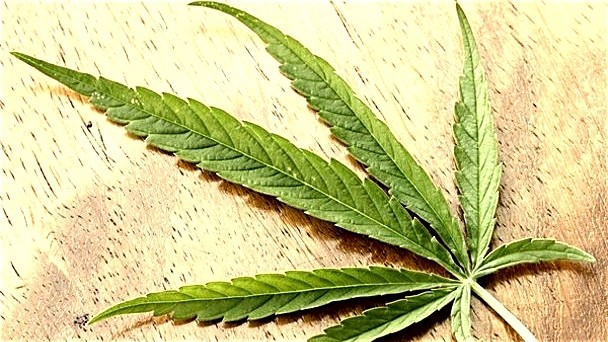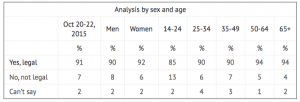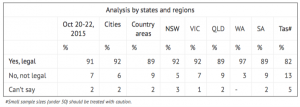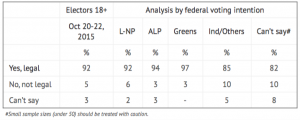This week Down Under
Poll shows overwhelming Australian support for legal medical marijuana

Last month, Roy Morgan Research telephoned 644 Australians over three days to find that just 7% stated they were against legalisation.
The landslide result comes from widespread support for the legalisation of medicinal marijuana among both men and women across different age groups, states of residence and federal voting intention.
Asked the question “In your opinion should the use of marijuana for medicinal purposes be made legal or remain illegal?”, 92% of women and 90% of men responded that yes, it should be made legal.
The strongest support for legalisation came from the 50-plus age group: 94% of Australians aged 50 and older said they believed medicinal marijuana should be legalised.
This is not surprising as this group is most susceptible to several of the conditions that medicinal marijuana can provide relief from, including Parkinson’s disease, cancer and glaucoma.
Least likely to support the idea was the 14-24 year-old age bracket, but still an overwhelming majority (85%) were in favour.
Western Australia showed the highest rate of support (97%), followed by New South Wales and Victoria (both 92%). Meanwhile, 89% of both South Australians and Queenslanders were in favour of legalisation.
While social attitudes frequently vary depending on an individual’s political preference, the issue of medicinal marijuana is not one of them, the poll found. Support for legalisation is similarly strong among Australians intending to vote for L-NP (92%) in the next federal election and those planning to vote for the ALP (94%), and almost unanimous among Green voters (97%).
Michele Levine, chief executive of Roy Morgan Research, said the results bode well for the federal government’s plan to legalise the growing of cannabis for medicinal purposes.
Levine said: “Part of the plan is to allow each state’s government to decide whether they would allow the drug to be grown. This will be of particular interest to Western Australia’s premier, Colin Barnett—not one of the movement’s most vocal supporters—whose state has the strongest support.”
Only one third of the population said they believed that the smoking of marijuana should be made legal, she added.
“This demonstrates that Australians understand that smoking and consuming marijuana for medicinal purposes are two very separate issues.”
More industry news from Down Under...
‘Wheat avoiders’ could be masking other digestive problems
A study examining the eating habits of more than 1,000 Australians shows that up to one in 10 adults are cutting wheat from their diets without conventional medical advice.
More than half of these so-called “wheat avoiders” blame nasty-meal aftereffects for their decision.
“The respondents to our survey link eating wheat with symptoms such as bloating or wind, stomach discomfort or cramps, and feeling sluggish or tired,” explained Sinead Golley, Csiro research fellow at the South Australian Health and Medical Research Institute and lead author of the study.
“They avoid wheat-based foods in an attempt to control their symptoms, but they are mostly doing it without any formal medical diagnosis that might indicate an intolerance or allergy.”
The results are of concern for Dr Golley and her colleagues, who believe that the decision to self-diagnose and control symptoms by avoiding wheat could have health consequences.
“Wholegrain cereals make a positive contribution to health by supplying a range of nutrients including protein, fibre and other carbohydrates, vitamins and minerals,” she said.
“By avoiding wheat, people may be missing out on very important nutrients. In addition, in bypassing medical advice through self-diagnosing they are potentially at risk of a serious clinical condition going undetected.”
The Pineapple genome and the genetic evolution of the drought tolerant fruit
Researchers have sequenced the genome of the pineapple, unlocking what makes it one of the most economically important fruits (Simone Mazengarb writes).
Previous research has shown the pineapple has a specific photosynthesis pathway associated with plants that use water more efficiently, making them better able to cope during drought conditions.
Now, for the first time, scientists from the University of Illinois and the University of Adelaide, in South Australia, have been able to show a link between this pathway and the circadian clock.
University of Adelaide scientists Vincent Bulone and Neil Shirley were asked to join the study in the last six months because of their work in cell wall metabolism, at the Australian Research Council’s centre for excellence in plant cell walls.
"What this shows is the pineapple has evolved from the type of photosynthesis that occurs in 95% of plants on the planet, known as C3,” said Professor Bulone.
"And the crassulacean acid metabolism, or CAM photosynthetic pathway, present in pineapples has evolved from pre-exiting genes in C3 plants, rather than through the acquisition of genes with new functions.”
Crassulacean acid metabolism is a photosynthetic pathway that maximises water use many times more efficiently than C3 species.
Professor Bulone said the discovery of the pineapple's genetic evolution to the CAM pathway and the capacity of pineapples to resist to arid conditions could play a long-term role in agricultural development.
"What is also important in this work, in terms of long-term in agricultural development, is the fact the pineapple has diverged from the lineage that has led to grasses and cereals, about 100m years ago.
"Therefore the pineapple is a very good model to compare with the evolution of cereals and grasses," he said.
The study was published this week in Nature Genetics.
Chr. Hansen to acquire DIAL culture production and strain collection
Dairy Innovation Australia Ltd (DIAL), which provides technical and research services for dairy manufacturing, has finalised the sale of its culture production unit and strain collection to Denmark’s Chr. Hansen and its Australian subsidiary.
The sale of this business unit is in line with the strategic review conducted by the DIAL Board. The deal is expected to be completed this month.
Peter Boyden, DIAL’s chairman, said: “Securing a key international purchaser in Chr. Hansen validates our decision to separate the cultures production unit from the remaining consultancy functions of DIAL.
“It is important to the DIAL Board to know the supply of cultures to the Australian industry will be serviced by a global leader in the sector.”
A leader in fermentation technology, Chr. Hansen has culture production facilities in Denmark, France, America, and with this acquisition, Australia.
“We look forward to nurturing the starter culture business within the Chr. Hansen family and becoming a stronger partner to our customers,” said Kylie Evans, country manager.
Some key DIAL staff will join Chr. Hansen, with production expected to continue at the Australian company’s existing facility for 12 months while a long-term future location is evaluated.
Recalls prompt regulator to remind companies of allergen labelling importance
The antipodean food regulator has reminded all business, including importers, of the need to meet mandatory allergen labelling requirements.
In a statement, Fsanz chief executive Steve McCutcheon said a number of coconut products had been recalled due to a lack of milk and milk products labelling.
“Allergens can be deadly and this is why the food standards code contains mandatory labelling requirements for nine allergens to ensure consumers have access to this vital information,” McCutcheon said.
“I remind any consumers who are allergic to milk or milk products to be mindful of recent recalls involving imported coconut products. Products have ranged from powders to coconut drinks and have been sold at smaller Asian retailers as well as larger outlets, chemists and online.
“State and territory enforcement agencies and the Commonwealth Department of Agriculture and Water Resources (for imported food) have been investigating similar products.”
Meanwhile, Fsanz has called for submissions on proposed changes to the maximum residue limits for agricultural and veterinary chemicals.
McCutcheon said the regulator has considered proposed changes to MRLs for chemicals that may legitimately occur in foods in Australia.
“Fsanz considers changes to the relevant standard at the request of applicants or because changes have been made by the Australian Pesticides and Veterinary Medicines Authority,” he said.
“Including these MRLs in the code will permit the sale of foods containing legitimate residues at levels which dietary assessments have confirmed are safe for human consumption.”
All Fsanz decisions on standards are notified to ministers responsible for food regulation. The ministers can decide to adopt, amend or reject standards, or they can ask for a review.
NZ floods may worsen 2016 lamb production
New Zealand lamb prices have increased 20% since June, in line with seasonal trends, though they are still down 2% over last year.
October prices in New Zealand increased 5% month on month as New Zealand entered the breeding season, when production is at its lowest.
September rains in Gisborne region, where the equivalent of one month’s rainfall fell in one day, caused large floods resulting in some farms importing feed for lambs and increased costs.
In response, farmers may cull produce early to reduce these higher costs, which would increase supply and cause prices to decrease.
El Niño tends to bring stronger winds to New Zealand, resulting in more frequent and severe weather. Since the flooding, severe weather has been forecast for the South Island, with high rainfall in October.
The 2016 season’s lamb production is estimated to fall 6% year on year to 355,000 tonnes, and severe weather could decrease production further.



















